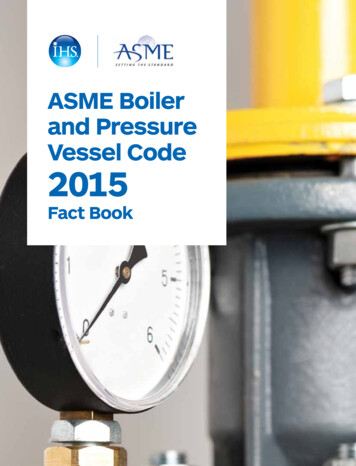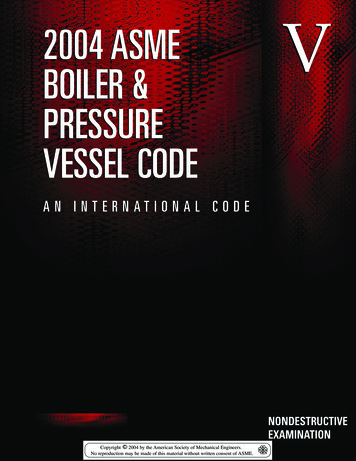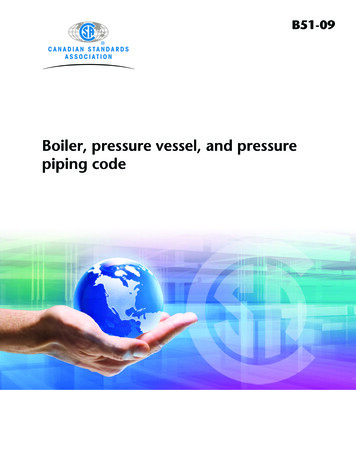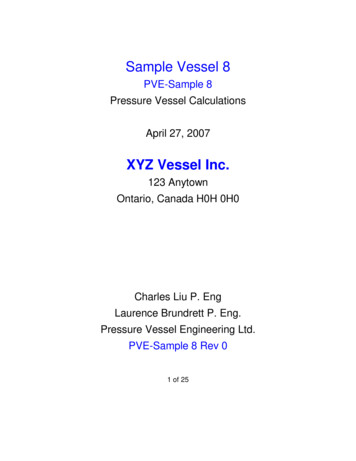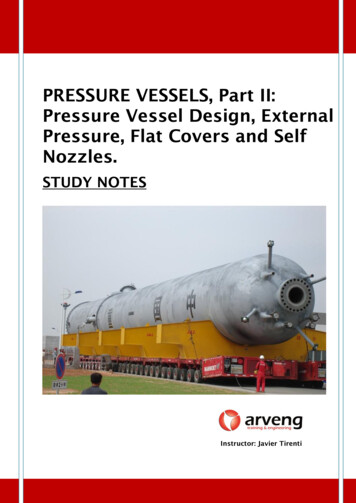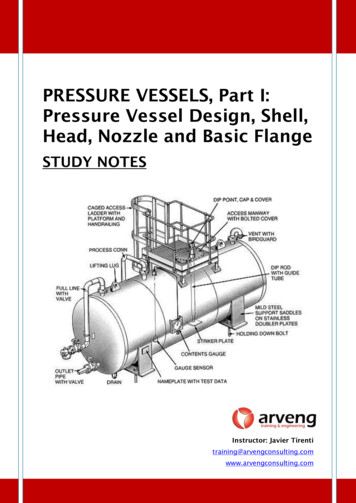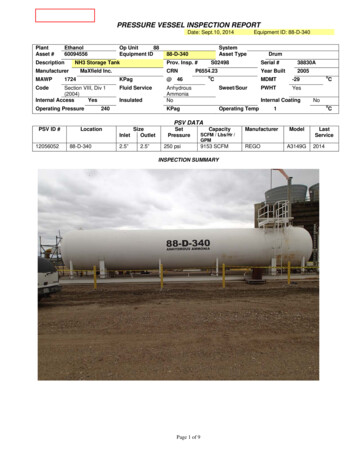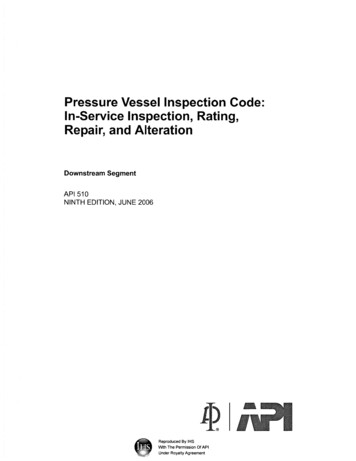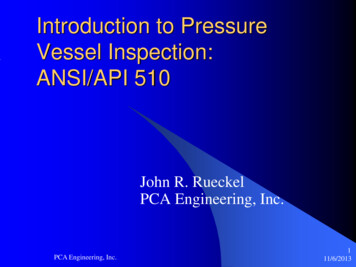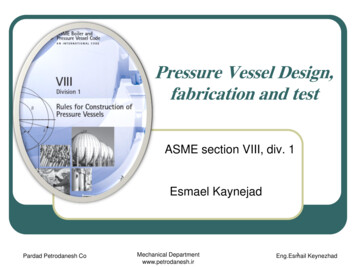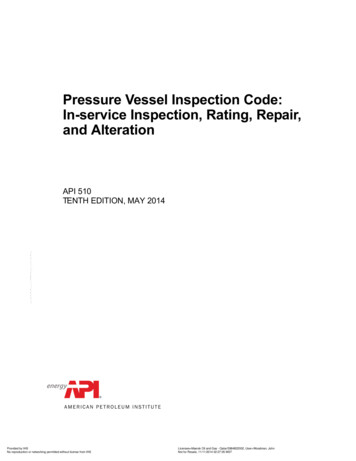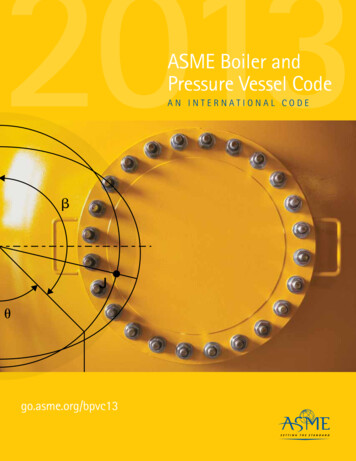
Transcription
ASME Boiler andPressure Vessel CodeAN INTERNATIONAL CODEgo.asme.org/bpvc13A
B
ASME’s Boiler and Pressure Vessel Code (BPVC) 2013A Century of SafetyWhen ASME’s founders—including HenryR. Worthington, Alexander Lyman Holleyand John Edson Sweet, along with otherprominent industrialists and technicalinnovators of the nineteenth century—gathered in New York City for the firsttime in 1880, the main topic of discussioncentered on the need for standardizedtools and machine parts as well as uniformwork practices in the dawning industrialage. Engineering standards, the foundersagreed, would ensure safety, reliability andoperational efficiency in machine designand mechanical production.ASME issued its first standard, Code forthe Conduct of Trials of Steam Boilers, in1884. This paper evolved into Rules forthe Construction of Stationary Boilers andfor Allowable Working Pressure—the firstedition of ASME’s now-legendary Boilerand Pressure Vessel Code (BPVC)—issued in1914 and published in 1915.The BPVC has grown over the decadesto include 28 books and 14,000 pagescovering industrial and residential boilersas well as nuclear reactor components,transport tanks, and other forms ofpressure vessels. It is kept current bynearly 1,000 volunteer technical experts—drawn from a balance of interests amongindustry, government and R&D—whooperate in a fully open and transparentmanner via consensus process.The resulting “living document” remains aworldwide model for assuring the safety,reliability and operational efficiency firstenvisioned by ASME’s founders more thana century ago.Boilers and Pressure VesselsSince its first issuance in 1914, ASME’sBPVC has pioneered modern standardsdevelopment, maintaining a commitmentto enhance public safety and technologicaladvancement to meet the needs of achanging world. This “International HistoricMechanical Engineering Landmark” nowhas been incorporated into the laws ofstate and local jurisdictions of the UnitedStates and nine Canadian provinces.More than 100,000 copies of the BPVCare in use in 100 countries around theworld, with translations into a numberof languages. The boiler and pressurevessel sections of the BPVC have longbeen considered essential within suchindustries as electric power-generation,petrochemical, and transportation,among others.NuclearASME has played a vital role in supportingthe nuclear industry since its inception,when ASME codes, standards andconformity assessment programs,originally developed for fossil fuel-firedplants, were applied to nuclear powerplant construction. Its widely-adoptedBPVC Section III, Rules for Constructionof Nuclear Facility Components, celebrates50 years in 2013.Presently, half of the world’s nuclearpower plants incorporate all or portionsof ASME nuclear codes and standardsin their construction, operation, and/or maintenance. Sixty nations generallyrecognize and apply the BPVC, while 30of the 44 nuclear nations purchase theirnuclear components to specificationscontained within ASME’s nuclear codesand standards. The nuclear sections of theBPVC reflect the best-practices of industry,while contributing to a full half-century ofsafety for the general public.go.asme.org/bpvc131
ASME’s Boiler and Pressure Vessel Code (BPVC) 2013Power BoilersSection I – Power BoilersReferenced BPVC SectionsReferenced ASME StandardsProvides requirements for all methodsof construction of power, electric, andminiature boilers; high temperature waterboilers, heat recovery steam generators,and certain fired pressure vessels to beused in stationary service; and powerboilers used in locomotive, portable, andtraction service. Rules pertaining to use ofthe single ASME certification mark with theV, A, M, PP, S, and E designators arealso included.BPVC-II, A, B, C, D -Section II, Materials, Parts A through DB1.20.1 -Pipe Threads, General Purpose, InchNew! Seccion IReglas para la construccion de calderasde energia(BPVC-I ES - 2010 )Section VII – Care of Power BoilersProvides guidelines to assist those directlyresponsible for operating, maintaining,and inspecting power boilers. Theseboilers include stationary, portable, andtraction type boilers, but not locomotiveand high-temperature water boilers,nuclear power-plant boilers (see SectionXI), heating boilers (see Section VI),pressure vessels, or marine boilers.Guidelines are also provided for operationof auxiliary equipment and appliances thataffect the safe and reliable operation ofpower boilers.2BPVC-V -Section V, Nondestructive ExaminationBPVC-VIII-1 -Section VIII, Rules for Construction ofPressure Vessels, Division 1BPVC-IX -Section IX, Welding and BrazingQualificationsTwelve Standards from the B16 Series onpipe flanges and fittingsB31.1 -Power PipingB36.10M -Welded and Seamless WroughtSteel PipePTC 25 -Pressure Relief DevicesQAI-1 -Qualifications for AuthorizedInspection
ASME’s Boiler and Pressure Vessel Code (BPVC) 2013Power Boilers - Product Certification PackagesA Designator:Assembly of Power BoilersE Designator:Electric BoilersACode Books Required:BPVC-I –Power BoilersCode Books Required:BPVC-I –BPVC-II – MaterialsEPower BoilersBPVC-V – Nondestructive ExaminationBPVC-IX – Welding and Brazing QualificationsPower PipingB31.1 –ORDER NO. BPVCBCode Books Required:BPVC-I –BPVC-II – MaterialsPart C – Specifications for WeldingRods, Electrodes and Filler MetalsB31.1 –M Designator:Miniature BoilersPart A – Ferrous Materials SpecificationsPart A – Ferrous Materials SpecificationsPart B – Nonferrous MaterialsSpecificationsPart B – Nonferrous MaterialsSpecificationsPart D – Properties (Customary or Metric)Part C – Specifications for Welding Rods,Electrodes and Filler MetalsPower PipingPart D – Properties (Customary or Metric)ORDER NO. BPVCEBPVC-IX – Welding and Brazing QualificationsCode Books Required:BPVC-I –Power BoilersCode Books Required:BPVC-I –Part B – Nonferrous MaterialsSpecificationsPart B – Nonferrous MaterialsSpecificationsPart D – Properties (Customary or Metric)BPVC-V – Nondestructive ExaminationBPVC-IX – Welding and Brazing QualificationsB31.1 –Power PipingORDER NO. BPVCAPower BoilersPart A – Ferrous Materials SpecificationsPart A – Ferrous Materials SpecificationsPart C – Specifications for Welding Rods,Electrodes and Filler MetalsVBPVC-II – MaterialsBPVC-II – MaterialsPart C – Specifications for Welding Rods,Electrodes and Filler MetalsPart D – Properties (Customary or Metric)BPVC-IX – Welding and Brazing QualificationsPTC 25 –Pressure Relief DevicesORDER NO. BPVCVPower PipingORDER NO. BPVCMV Designator:Boiler Safety ValvesPPPower BoilersBPVC-II – MaterialsB31.1 –PP Designator:Pressure PipingS Designator:Power BoilersMCode Books Required for Use with ASME ProductCertification MarksNote: For books other than the Boiler & Pressure VesselCode (e.g., B31.1, PTC 25, NQA-1), the required edition asof July 1, 2013 is listed. The specific effective Addenda willbe referenced in the applicable Boiler and Pressure VesselCode section. Later editions of these referenced books willbe required if and when referenced by the applicable Boilerand Pressure Vessel Code section.* Sections II and IX are not required for assemblers.Section II, Part C, and Section IX are not required formanufacturers if welding and brazing are not within thescope of their work.Note: Effective January 1, 2013, ASME is replacingits former “code symbol stamps” with one ProductCertification Mark, as illustrated on these pages.Individual product certifications will be identified withtheir respective Product Certification Designators(e.g., “S,”“E,” etc.).3
ASME’s Boiler and Pressure Vessel Code (BPVC) 2013Heating BoilersSection IV – Heating BoilersReferenced BPVC SectionsProvides requirements for design,fabrication, installation and inspectionof steam heating, hot water heating, hotwater supply boilers, and potable waterheaters intended for low pressure servicethat are directly fired by oil, gas, electricity,coal or other solid or liquid fuels. Rulespertaining to use of the single ASMEcertification mark with the H, HV, and HLWdesignators are also included.BPVC-I -Section I, Rules for Construction ofPower BoilersSection VI – Care and Operation ofHeating BoilersCovers operation guidelines applicable tosteel and cast-iron boilers limited to theoperating ranges of Section IV HeatingBoilers. Section VI includes guidelinesfor associated controls and automaticfuel-burning equipment. Also included isa glossary of terms commonly associatedwith boilers, controls, and fuelburning equipment.4BPVC-II, A, B, C, D -Section II, Materials, Parts A through DBPVC-IX -Section IX, Welding and BrazingQualificationsReferenced ASME StandardsSeven Standards from the B16 Series onpipe flanges and fittingsPTC 25 -Pressure Relief DevicesQAI-1 -Qualifications for AuthorizedInspection
ASME’s Boiler and Pressure Vessel Code (BPVC) 2013Heating Boilers - Product Certification PackagesH Designator:Cast Iron Section Heating BoilersCode Books Required:H Designator:Field Assembly of BoilersHHCode Books Required:BPVC-IV – Section IV, Heating BoilersBPVC-IV – Section IV, Heating BoilersORDER NO. BPVCH2BPVC-IX – Section IX, Welding and BrazingQualificationsORDER NO. BPVCHH Designator :Heating Boilers, Except Cast IronHLW Designator :Lined Potable Water HeatersHCode Books Required:BPVC-II – Section II, MaterialsHV Designator :Heating Boiler Safety ValvesCode Books Required:BPVC-II – Section II, MaterialsHVPart A – Ferrous Materials SpecificationsPart A – Ferrous Materials SpecificationsPart B – Nonferrous MaterialsSpecificationsPart B – Nonferrous MaterialsSpecificationsPart C – Specifications for Welding Rods,Electrodes and Filler MetalsPart C – Specifications for Welding Rods,Electrodes and Filler MetalsBPVC-IV – Section IV, Heating BoilersBPVC-IV – Section IV, Heating BoilersBPVC-IX – Section IX, Welding and BrazingQualificationsBPVC-IX – Section IX, Welding and BrazingQualificationsORDER NO. BPHLWPTC-25 –Pressure Relief DevicesORDER NO. BPVHV5
ASME’s Boiler and Pressure Vessel Code (BPVC) 2013Pressure VesselsSection VIII – Pressure VesselsDivision 1 provides requirementsapplicable to the design, fabrication,inspection, testing, and certificationof pressure vessels operating at eitherinternal or external pressures exceeding15 psig. Such vessels may be fired orunfired. This pressure may be obtainedfrom an external source or by theapplication of heat from a direct orindirect source, or any combinationthereof. Specific requirements apply toseveral classes of material used inpressure vessel construction, and alsoto fabrication methods such as welding,forging and brazing.Division 1 contains mandatory andnon-mandatory appendices detailingsupplementary design criteria,nondestructive examination andinspection acceptance standards. Rulespertaining to the use of the single ASMEcertification mark with the U, UM and UVdesignators are also included.6Division 2 requirements on materials,design, and nondestructive examinationare more rigorous than in Division 1;however, higher design stress intensifyvalues are permitted. These rules mayalso apply to human occupancy pressurevessels typically in the diving industry.Rules pertaining to the use of the singleASME certification mark with the U2 andUV designators are also included.Division 3 requirements are applicableto pressure vessels operating at eitherinternal or external pressures generallyabove 10,000 psi. It does not establishmaximum pressure limits for either SectionVIII, Divisions 1 or 2, nor minimum pressurelimits for this Division. Rules pertainingto the use of the single ASME certificationmark with the U3 and UV3 designator arealso included.Referenced BPVC SectionsBPVC-II, A, B, C, D -Section II, Materials, Parts A through DBPVC-V -Section V, Nondestructive ExaminationBPVC-IX -Section IX, Welding and BrazingQualifications
7
ASME’s Boiler and Pressure Vessel Code (BPVC) 2013Pressure Vessels, continuedReferenced ASME StandardsDivision 2:Division 3:Division 1:API 579-1/ASME FFS-1 –Fitness-For-ServiceAPI 579-1/ASME FFS-1 –Fitness-For-ServiceFive Standards from the B1 Series onscrew threadsThirteen Standards from the B16 Serieson pipe flanges and fittingsNine Standards from the B18 Series onhex boltsB36.10M -Welded and Seamless WroughtSteel PipeB36.19M -Stainless Steel PipeNQA-1 -Quality Assurance ProgramRequirements for Nuclear FacilitiesPCC-1 -Guidelines for Pressure BoundaryBolted Flange Joint AssemblyPCC-2 -Repair of Pressure Equipmentand PipingPTC 25 -Pressure Relief DevicesQAI-1 -Qualifications forAuthorized Inspection8Three Standards from the B1 Series onscrew threadsThree Standards from the B1 Series onscrew threadsNine Standards from the B16 Series onpipe flanges and fittingsFour Standards from the B16 Series onpipe flanges and fittingsFour Standards from the B18 Series onhex boltsSeven Standards from the B18 Series onhex boltsB36.10M -Welded and Seamless WroughtSteel PipeB36.10M -Welded and Seamless WroughtSteel PipeB36.19M -Stainless Steel PipeB46.1 –Surface Texture (Surface Roughness,Waviness and Lay)NQA-1 -Quality Assurance ProgramRequirements for Nuclear FacilitiesPCC-1 -Guidelines for Pressure BoundaryBolted Flange Joint AssemblyPTC 25 -Pressure Relief DevicesQAI-1 -Qualifications forAuthorized InspectionPTC 25 -Pressure Relief DevicesQAI-1 -Qualifications forAuthorized Inspection
ASME’s Boiler and Pressure Vessel Code (BPVC) 2013Pressure Vessels - Product Certification PackagesProduct Certification Packages – Div 3Product Certification Packages -- AllUD Designator:Rupture Disc DevicesUV Designator:Pressure Vessels Safety ValvesCode Books Required:Code Books Required:UVBPVC-II – Section II, MaterialsPart A – Ferrous Materials SpecificationsBPVC-II – Section II, MaterialsPart B – Nonferrous MaterialsSpecificationsPTC-25 –Part A – Ferrous Materials SpecificationsBPVC-VIII-1 – Section VIII, Pressure Vessels,Division 1PTC-25 –Pressure Relief DevicesPart B – Nonferrous MaterialsSpecificationsPart C – Specifications for We
Section VII – Care of Power Boilers Provides guidelines to assist those directly responsible for operating, maintaining, and inspecting power boilers. These boilers include stationary, portable, and traction type boilers, but not locomotive and high-temperature water boilers, nuclear power-plant boilers (see Section
